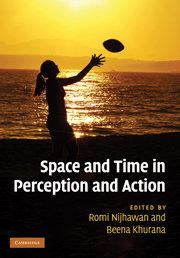Book contents
- Frontmatter
- Contents
- List of contributors
- Acknowledgments
- 1 Space and time: the fabric of thought and reality
- Part I Time–space during action: perisaccadic mislocalization and reaching
- Part II Temporal phenomena: perception
- Part III Temporal phenomena: binding and asynchrony
- Part IV Spatial phenomena: forward shift effects
- 19 The Fröhlich effect: past and present
- 20 Approaches to representational momentum: theories and models
- 21 Conceptual influence on the flash-lag effect and representational momentum
- 22 Perceptual asynchronies and the dual-channel differential latency hypothesis
- 23 Paying attention to the flash-lag effect
- 24 Illusions of time, space, and motion: flash-lag meets chopsticks and reversed phi
- 25 Bridging the gap: a model of common neural mechanisms underlying the Fröhlich effect, the flash-lag effect, and the representational momentum effect
- 26 Perceiving-the-present and a unifying theory of illusions
- 27 History and theory of flash-lag: past, present, and future
- Part V Space–time and awareness
- Index
- References
24 - Illusions of time, space, and motion: flash-lag meets chopsticks and reversed phi
from Part IV - Spatial phenomena: forward shift effects
Published online by Cambridge University Press: 05 October 2010
- Frontmatter
- Contents
- List of contributors
- Acknowledgments
- 1 Space and time: the fabric of thought and reality
- Part I Time–space during action: perisaccadic mislocalization and reaching
- Part II Temporal phenomena: perception
- Part III Temporal phenomena: binding and asynchrony
- Part IV Spatial phenomena: forward shift effects
- 19 The Fröhlich effect: past and present
- 20 Approaches to representational momentum: theories and models
- 21 Conceptual influence on the flash-lag effect and representational momentum
- 22 Perceptual asynchronies and the dual-channel differential latency hypothesis
- 23 Paying attention to the flash-lag effect
- 24 Illusions of time, space, and motion: flash-lag meets chopsticks and reversed phi
- 25 Bridging the gap: a model of common neural mechanisms underlying the Fröhlich effect, the flash-lag effect, and the representational momentum effect
- 26 Perceiving-the-present and a unifying theory of illusions
- 27 History and theory of flash-lag: past, present, and future
- Part V Space–time and awareness
- Index
- References
Summary
Summary
In the “chopstick illusion” (Anstis 1990, 2003) a vertical and horizontal line overlapped to form a cross and followed clockwise circular orbits in counterphase, with one line being at 6 o'clock when the other was at 12 o'clock. The intersection of the lines moved counterclockwise, but it was wrongly perceived as rotating clockwise. This chopstick illusion reveals how moving objects are parsed, based upon the intrinsic and extrinsic terminators of lines viewed through apertures. We conclude that intersections were not parsed as objects, but instead the motion of the terminators (tips) propagated along the lines and was blindly assigned to the intersection. In the similar “sliding rings illusion,” we found that observers could use their eyes to track intersections only when these appeared rigid and not when they appeared to slide. Conclusion – smooth pursuit eye movements are under top-down control and are compelled to rely upon perceptual interpretation of objects.
In the “flash-lag” effect, a static object that is briefly flashed up next to a moving object appears to lag behind the moving object (Nijhawan 2002). We superimposed a flashed spot on a chopsticks intersection that appeared to be moving clockwise along a circular path but was actually moving counterclockwise. We found that the flash appeared displaced clockwise. This was appropriate to the physical, not the subjective direction of rotation, indicating that the flash-lag and the chopstick illusions coexist without interacting. Similarly, the flash-lag effect was unaffected by reversed phi. […]
Information
- Type
- Chapter
- Information
- Space and Time in Perception and Action , pp. 408 - 421Publisher: Cambridge University PressPrint publication year: 2010
References
Accessibility standard: Unknown
Why this information is here
This section outlines the accessibility features of this content - including support for screen readers, full keyboard navigation and high-contrast display options. This may not be relevant for you.Accessibility Information
- 1
- Cited by
